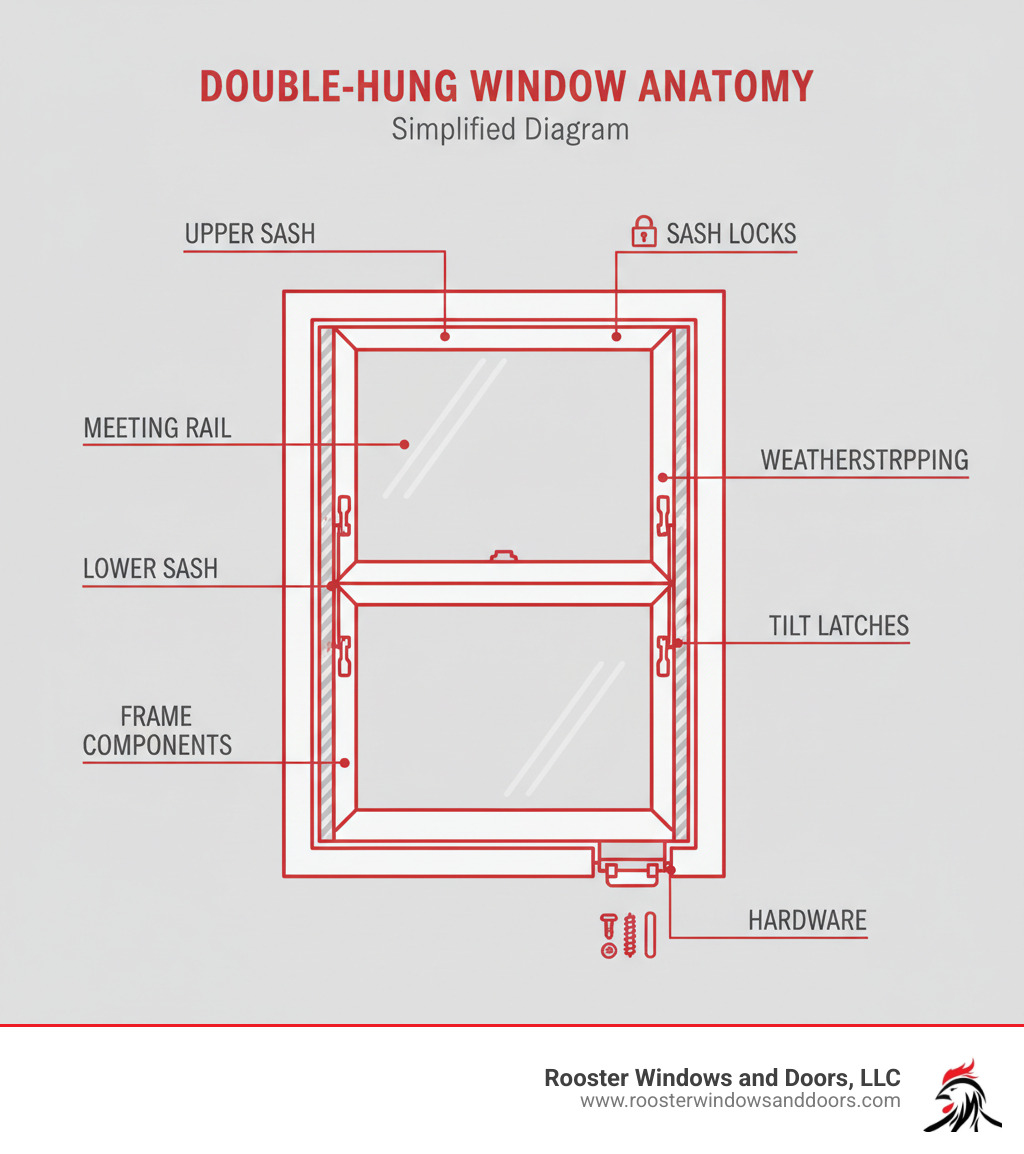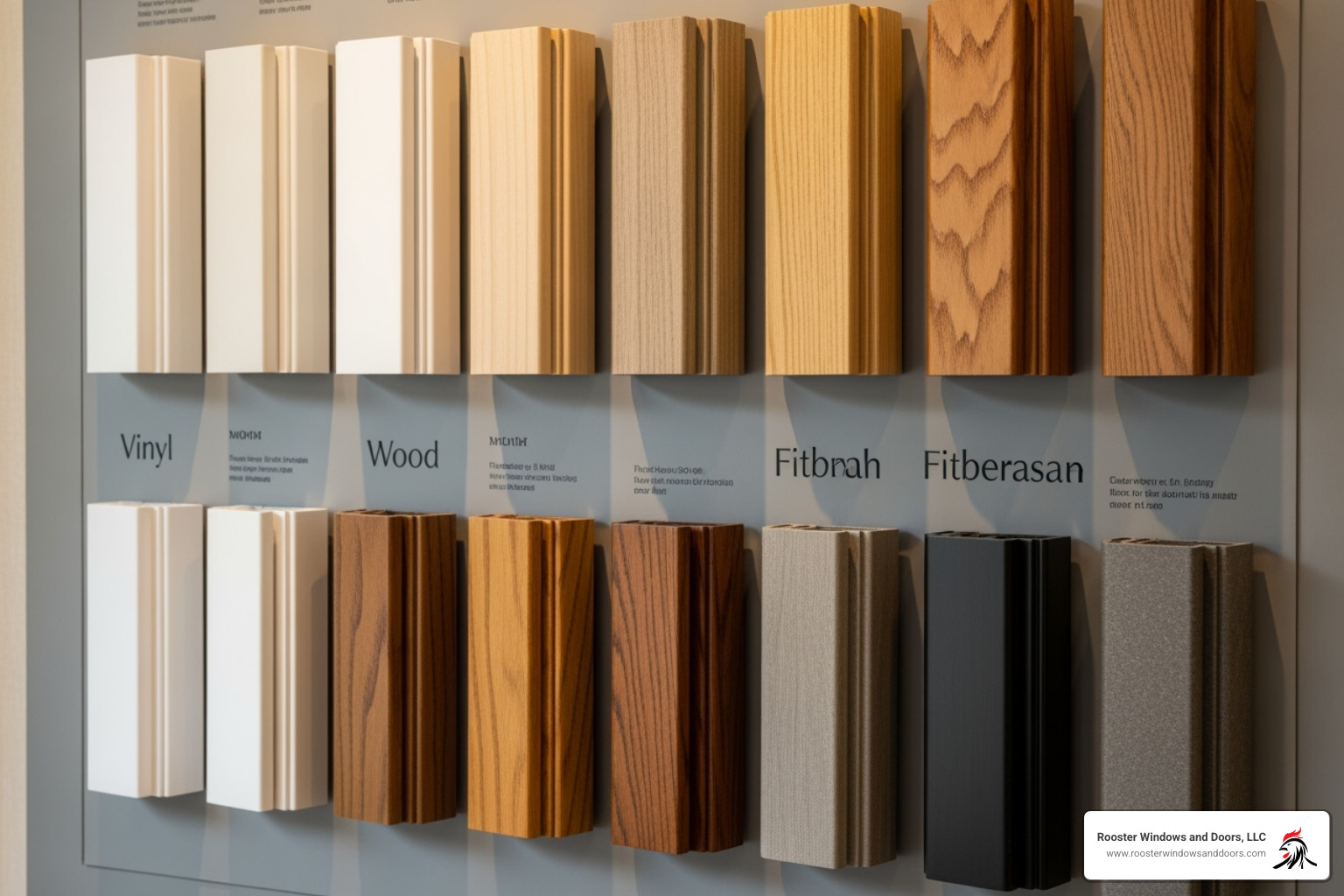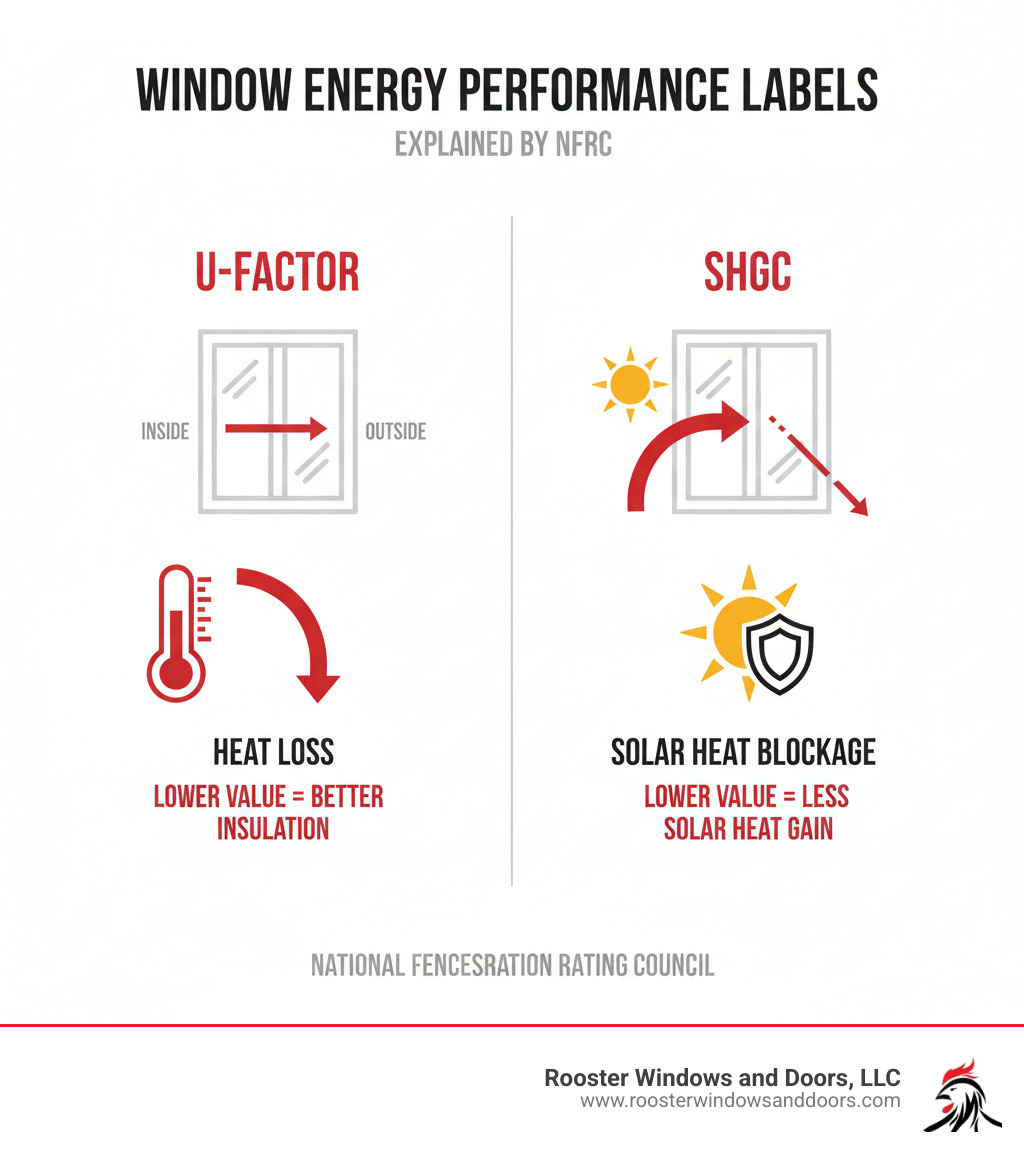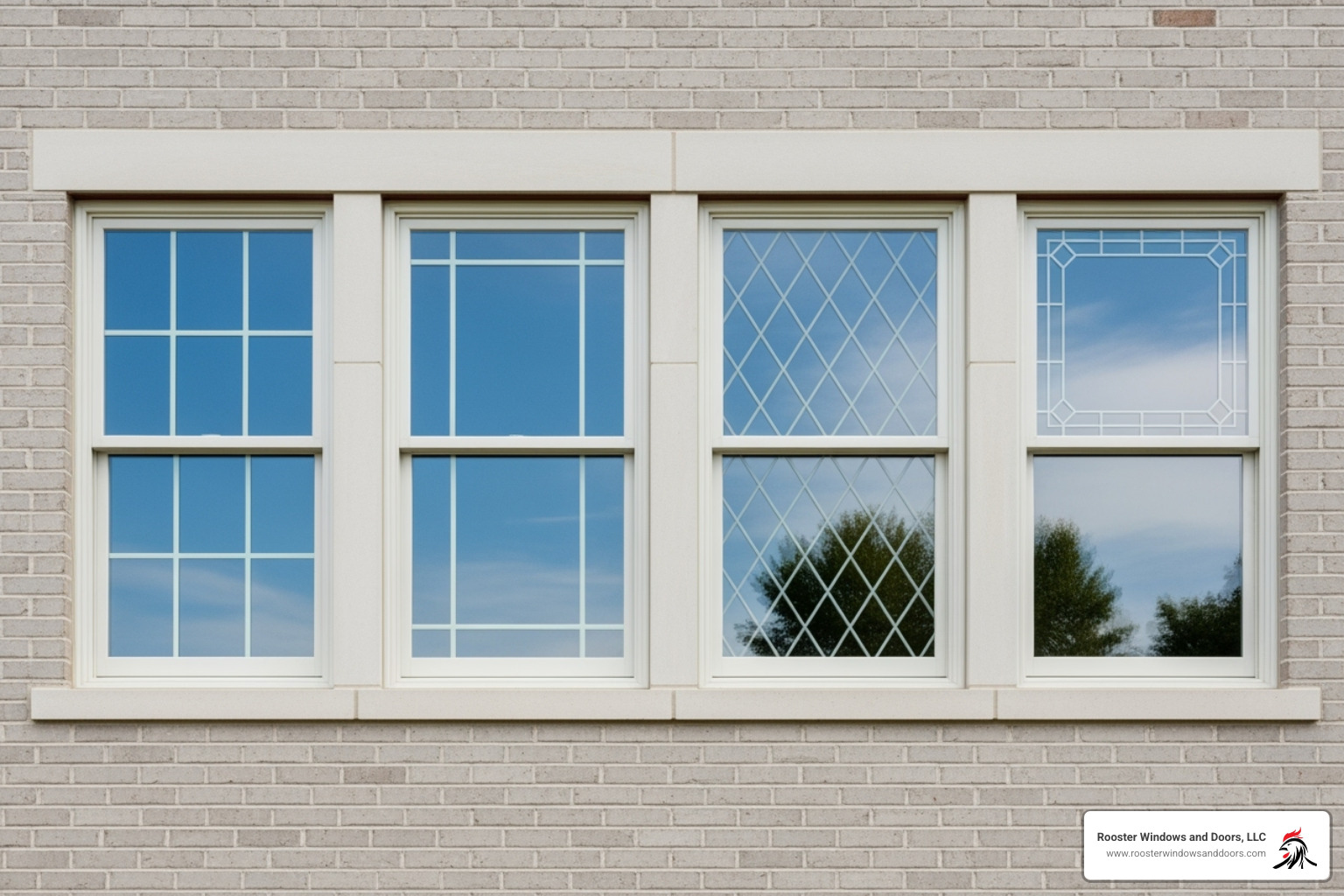Why Double-Hung Windows Remain America’s Most Popular Choice
Double hung window options offer homeowners the perfect blend of classic design and modern functionality, making them the most popular window style in American homes today. Whether you’re building new or replacing existing windows, understanding your options helps you make the best choice for your home’s comfort, energy efficiency, and curb appeal.
Quick Answer: Your Main Double-Hung Window Options Include:
- Frame Materials: Vinyl (most affordable), Wood (premium aesthetics), Fiberglass (best durability), Aluminum-clad (low maintenance)
- Glass Packages: Double-pane (standard), Triple-pane (maximum efficiency), Low-E coatings (energy savings), Argon gas fill (better insulation)
- Customization: Grid patterns (Colonial, Prairie, Diamond), Hardware finishes (Bronze, Nickel, Black), Exterior colors, Screen types
- Sizes: Standard widths 24″-48″, Heights 36″-72″, Custom sizes available for unique openings
- Price Range: $395-$1,051+ depending on materials, glass, and features
Double-hung windows feature two vertically sliding sashes that both open independently. This design allows you to open the bottom sash to let cool air in while opening the top sash to let warm air escape – creating natural convection cooling that can reduce your energy bills.
The tilt-in cleaning feature makes maintenance simple and safe, even on upper floors. Both sashes tilt inward, allowing you to clean the exterior glass from inside your home without ladders or professional cleaning services.
As Piotr Wilk from Rooster Windows and Doors, I’ve been installing double hung window options across the Chicagoland area for over two decades, helping homeowners choose the perfect combination of materials, glass packages, and features for their specific needs. My experience has shown that the right double-hung windows can transform both the comfort and appearance of any home.

Understanding the Basics: What is a Double-Hung Window?
A double-hung window is a classic style featuring two operable sashes that slide vertically in the frame. This dual-sash design is what gives them their unique functionality and enduring popularity.
This design allows for superior ventilation. You can open the bottom sash to let in cool, fresh air while opening the top sash to let warm, stale air escape. This creates a natural convection current that can help cool your home without relying on air conditioning.
One of the most celebrated features of modern double-hung windows is their easy cleaning. Both sashes tilt inward, allowing you to clean the exterior glass from the safety and comfort of your home. This is especially convenient for second-story windows, eliminating the need for ladders.
The timeless design of double-hung windows complements nearly any architectural style, from traditional to modern. To learn more about how they compare to a similar style, explore our guide on Double Hung vs Single Hung Windows.
Key Benefits of Double-Hung Windows
When considering double hung window options, it’s helpful to understand the benefits they bring to a home:
- Improved Airflow and Convection Cooling: By opening both sashes, you create a natural convection current. Hot air rises and exits through the top, while cooler air is drawn in through the bottom, reducing your reliance on air conditioning.
- Ease of Maintenance: The tilt-in feature is a game-changer. Both sashes tilt inward, allowing for effortless and safe cleaning of both sides of the glass from inside your home.
- Space-Saving Design: Unlike windows that crank outward, double-hung windows operate within their frame. This makes them ideal for areas near walkways, patios, or decks, as they don’t protrude into the space.
- Versatility for Home Styles: Their clean lines and traditional look make them a perfect fit for a wide range of architectural styles, from historic homes to contemporary builds.
- Increased Safety: Modern double-hung windows often come with advanced locking mechanisms and limit latches. These features allow you to secure the window in a partially open position for ventilation without compromising security.
Single-Hung vs. Double-Hung: What’s the Difference?
While they look similar, the key difference between single-hung and double-hung windows is their sash operation, which affects ventilation, cleaning, and cost.
| Feature | Single-Hung Windows | Double-Hung Windows |
|---|---|---|
| Sash Operation | Only the bottom sash moves vertically; top sash is fixed. | Both top and bottom sashes move vertically and can tilt in. |
| Ventilation | Limited to bottom opening; less effective convection. | Variable ventilation from top, bottom, or both; excellent convection. |
| Cleaning | Exterior of fixed top sash can be difficult to clean; bottom sash may tilt. | Both sashes tilt inward, allowing easy cleaning of exterior glass from inside. |
| Cost | Generally more affordable due to simpler design. | Typically higher cost due to more complex mechanics and features. |
| Energy Efficiency | Can be slightly more energy-efficient due to fixed top sash (less potential for air leakage). | Highly efficient with modern features like weatherstripping and insulated glass, though fixed sash of single-hung can sometimes offer a tighter seal. |
The most significant difference is the fixed top sash in single-hung windows, which limits ventilation to the bottom half. This simpler design can lead to a lower price point, but it sacrifices the superior airflow and easy cleaning of a double-hung window.
Conversely, the two moving sashes in a double-hung window provide unparalleled flexibility for ventilation and maintenance. While single-hung windows are often more budget-friendly, many homeowners find the long-term benefits of improved airflow and easier cleaning make the investment in double hung window options a worthwhile one.
Exploring Your Double-Hung Window Options
Once you’ve decided that double-hung windows are the right choice, the next step is exploring the vast array of double hung window options available. We can help you steer the choices in materials, energy performance, and aesthetics to find the perfect match for your home in Illinois.

Understanding how windows contribute to your home’s energy performance is key. We look at factors like U-Factor (how well a window prevents heat from escaping) and Solar Heat Gain Coefficient (SHGC – how well a window blocks heat from the sun), which are detailed on labels from the National Fenestration Rating Council (NFRC).

Frame Materials: Finding the Right Fit
The frame material you choose impacts your window’s appearance, durability, maintenance, and performance. We offer a range of materials, each with its own pros and cons:
- Vinyl:
- Pros: The most affordable and popular choice, vinyl is exceptionally low maintenance, never needs painting, and resists rot and insects. Modern vinyl windows offer great durability and insulation.
- Cons: Color options can be more limited compared to other materials, and lower-quality vinyl may be less rigid.
- Wood:
- Pros: Offers best natural beauty and warmth. Wood is a great natural insulator and can be painted or stained to match any design.
- Cons: The most expensive option, wood requires regular maintenance (painting or sealing) to protect it from moisture and rot.
- Fiberglass:
- Pros: Incredibly strong, durable, and resistant to warping or cracking in extreme temperatures. Fiberglass is energy-efficient, low maintenance, and has a long lifespan.
- Cons: Typically more expensive than vinyl, though often less than high-end wood options.
- Aluminum-Clad:
- Pros: Features a beautiful wood interior with a durable, low-maintenance aluminum exterior. This combination offers the best of both worlds: classic interior aesthetics and excellent weather resistance.
- Cons: These are among the more expensive double hung window options, and the interior wood still requires some care.
Glass Packages: The Key to Energy Efficiency
The glass package is crucial for your home’s energy efficiency and comfort. We focus on options that help our clients save on energy bills.
- Double-Pane Glass: The current standard, featuring two panes of glass with an insulating air or gas-filled space. It’s a significant upgrade over old single-pane windows.
- Triple-Pane Glass: For maximum efficiency and sound dampening, especially in cold climates like Chicagoland, three panes of glass provide superior insulation.
- Low-E Coatings (Low-Emissivity): A microscopic metallic coating that reflects heat, keeping your home warmer in winter and cooler in summer.
- Argon Gas Fill: A dense, inert gas used to fill the space between glass panes, slowing heat transfer and improving insulation.
- Tempered Glass: A safety glass that shatters into small, blunt pieces if broken, reducing the risk of injury. Recommended for doors and bathrooms.
- Laminated Glass: Offers superior security and sound reduction. If the glass breaks, fragments adhere to a plastic interlayer.
These advanced glass options help windows achieve Energy Star-certified ratings. To further improve your window’s insulating capabilities, consider our tips on How to Insulate Windows.
Customization and Aesthetic Double-Hung Window Options
Beyond performance, the look of your windows defines your home’s character. We offer extensive customization to match your vision.

- Grids and Grilles: Add character by dividing the glass. Options include Simulated Divided Lites (SDL) for an authentic look or Grids Between the Glass (GBG) for easy cleaning. Popular patterns include Colonial, Prairie, and Diamond.
- Hardware Finishes: Details matter. We offer a variety of finishes for locks and handles, including brushed nickel, oil-rubbed bronze, and black, to complement your décor.
- Color Choices: While white is standard, we offer a wide palette of exterior colors to boost curb appeal. Wood interiors can be stained or painted to match your home.
- Screen Options: Screens are essential for ventilation. We offer modern, flexible screens like FlexScreen, high-clarity mesh, and traditional fiberglass screens.
- Suitability for Different Home Styles: Double-hung windows are versatile, perfectly suiting Craftsman, Colonial, Farmhouse, Victorian, and even contemporary homes.
How Double-Hung Windows Compare to Other Styles
When exploring double hung window options, it’s helpful to see how they stack up against other popular styles. Each type has its own strengths, and understanding them helps you choose the right window for the right location.
-
Functionality: Double-hung windows offer versatile ventilation by opening from the top, bottom, or both. Casement windows crank outward like a door, providing full ventilation but potentially obstructing walkways. Sliding windows move horizontally, opening up to half their width. Picture windows are fixed and offer no ventilation.
-
Aesthetics: Double-hung windows have a classic, symmetrical look that fits almost any architectural style. Casements offer a more contemporary, European feel with large, uninterrupted panes of glass. Sliders have a clean, modern appearance, while picture windows create dramatic focal points with expansive views.
-
Cost: Double-hung windows are typically a mid-range option—more than basic sliders but often less than premium casements. Casement windows can cost more due to their complex crank mechanisms. Sliding windows are usually one of the most budget-friendly operable styles, while picture window costs vary widely with size.
-
Air Leakage: Modern, high-quality double hung window options with advanced weatherstripping perform exceptionally well. However, casement windows are often considered the most airtight, as the sash presses firmly against the frame like a refrigerator door. Picture windows, being fixed, have the least potential for air leakage.
-
Unobstructed Views: Picture windows are the clear winner here, offering nothing but glass. Casement windows also provide excellent, open views. Double-hung windows have a horizontal meeting rail in the middle, and sliders have a vertical one, both of which divide the view.
Many homes benefit from a combination of window styles. We often install double-hung windows throughout a home for their versatility, using a casement over a kitchen sink for maximum airflow or a picture window in a living room to frame a beautiful view. The key is matching the window type to its specific function and location.
Practical Considerations for Your Project
When you’re ready to move forward with your double hung window options, a few practical considerations will ensure your project’s success. Proper planning saves time and money.
The first decision is whether you need new construction or replacement windows. New construction offers complete design freedom. For replacement projects, you can choose a full-frame replacement (removing everything down to the rough opening for better performance) or an insert (fitting a new window into the existing frame, which is more budget-friendly). Our Window Installation Services: Complete Guide details what to expect.
Professional installation is critical. Even the best windows will fail if not properly sealed, leveled, and secured. Our commitment to high-quality, flawless, and energy-efficient installations ensures your windows perform as designed. Also, pay attention to warranty considerations. Look for strong manufacturer warranties, which we back with our own labor warranty for up to 25 years.
Finally, plan for ongoing window maintenance. While modern windows are low-maintenance, simple care extends their lifespan. Our Window Maintenance guide offers tips to keep your windows operating smoothly for decades.
Understanding Costs and Budgeting
Understanding the investment helps you make smart decisions about your double hung window options. The national average cost for a double-hung window is around $608, but your final price will depend on several factors.
- Materials: Vinyl is the most affordable, while wood is a premium choice. Fiberglass and aluminum-clad options fall in the middle.
- Glass Package: Upgrading to triple-pane glass with Low-E coatings and argon gas increases the initial cost but can dramatically reduce energy bills over time.
- Size and Customization: Larger or custom-sized windows, unique grid patterns, and premium hardware will increase the cost.
- Installation Labor: This is a significant portion of the total cost and reflects the expertise required for a flawless, energy-efficient installation that lasts.
When evaluating costs, consider the long-term value. Energy-efficient windows can cut heating and cooling bills, and they boost your home’s curb appeal and resale value. For more details, see our Cost to Replace a Window: Ultimate Guide.
Finding a Professional for Installation
Choosing the right installer is as important as selecting the right double hung window options. Poor installation can lead to drafts, leaks, and operational issues, negating the benefits of a high-quality window.
Professional installation ensures your windows are perfectly plumb, level, and square, with proper sealing and insulation. This is the key to long-term performance and energy efficiency. Our installers are trained, certified, and experienced, and we stand behind our work with comprehensive warranties.
When searching for installers, our guide to the Best Window Installation Companies offers valuable insights. You can also find qualified professionals through resources like Window Installers Near Me. We pride ourselves on being a trusted contractor serving the Chicagoland area, committed to transparent communication and meticulous work.
Frequently Asked Questions about Double-Hung Windows
Over two decades of installing windows in Chicagoland, I’ve heard the same questions from homeowners. Here are the answers to the most common concerns about double hung window options.
Are double-hung windows less energy-efficient than other types?
This is a common misconception. Modern, high-quality double-hung windows are highly energy-efficient. While older models may have been drafty, today’s windows feature advanced weatherstripping and interlocking sashes that create a tight seal. When combined with an energy-efficient glass package (like double or triple-pane glass with Low-E coatings and argon gas), they easily meet or exceed ENERGY STAR standards.
The key to energy efficiency is not the window style, but the quality of its construction, the glass technology, and most importantly, a flawless professional installation. If you’re seeing moisture on your windows, our guide on Condensation on Windows can help you diagnose the issue.
What is the typical lifespan of a double-hung window?
The lifespan of your windows depends heavily on the frame material, installation quality, and maintenance. Here’s a general breakdown:
- Vinyl windows typically last 20 to 40 years.
- Wood windows can last 30 years or more, often exceeding 50 years with proper maintenance (regular painting or staining).
- Fiberglass windows are known for their longevity, frequently lasting 50 years or more.
- Aluminum-clad windows generally last 30 to 40 years, combining a durable exterior with a protected wood interior.
These estimates assume professional installation and regular care. A poorly installed window will not reach its potential lifespan, regardless of the material.
How do I clean the outside of a second-story double-hung window?
This is one of the best features of modern double hung window options. You don’t need a ladder. Both the upper and lower sashes are designed to tilt inward, allowing you to clean the exterior glass from inside your home.
Simply open up the tilt latches, usually found on the top of each sash, and gently pull the sash toward you. It will pivot inward, giving you easy access to the outside surface. Once you’re done cleaning, tilt the sash back into place and lock it. It’s a simple, safe, and convenient feature that makes window maintenance much easier, especially for upper floors.
Conclusion
After exploring all these double hung window options, you can see why they’ve remained America’s favorite window style for generations. These remarkable windows truly offer the best of both worlds – that classic, timeless appeal that makes any home look neat, combined with modern functionality that makes daily life more comfortable.
Whether you’re drawn to the affordability of vinyl, the natural warmth of wood, or the incredible durability of fiberglass, there’s a perfect match for your home and budget. The beauty lies in the details – from choosing the right glass package to maximize your energy savings, to selecting grid patterns that complement your home’s architectural style, to picking hardware finishes that tie everything together beautifully.
What really sets double-hung windows apart is their incredible versatility. They work just as well in a charming farmhouse as they do in a sleek contemporary home. The superior ventilation from both sashes creates that wonderful natural cooling effect, while the tilt-in cleaning feature means you’ll never have to worry about dangerous ladder work again.
The importance of quality materials and professional installation cannot be overstated. Even the most beautiful, energy-efficient window won’t perform properly if it’s not installed correctly. That’s where we come in – our team has been perfecting window installations across the Chicagoland area for over two decades, and we take tremendous pride in our flawless, energy-efficient work.
At Rooster Windows and Doors, we understand that choosing new windows is a significant investment in your home’s future. We’re here to guide you through every decision, from that first consultation where we discuss your needs and preferences, to the final walkthrough where we make sure everything is absolutely perfect.
Ready to transform your home with beautiful, high-performing windows? We’d love to show you our comprehensive Window Services and help you explore our premium selection of Double Hung Windows. Your dream windows are waiting – let’s make them a reality together.